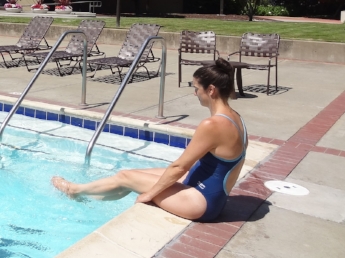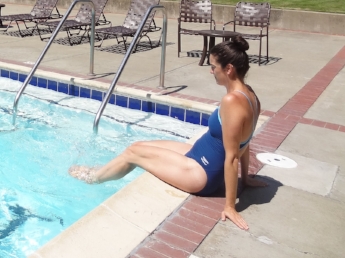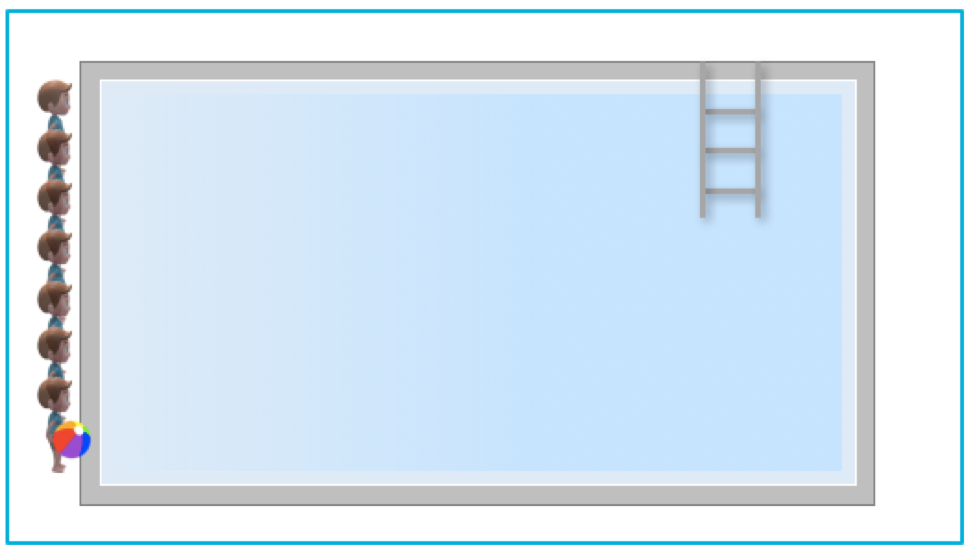TECHNIQUE
Today we are going to learn how to do half-submerged water skills.
IMPORTANCE
Half-submerged water skills are important to learn because they help new swimmers get used to the pool and familar with some of the swim skills we will be learning. For those who already know how to swim, it is important to review these skills before we begin swimming as a class.
VOCABULARY
Half-submerged: to have half your body under the surface of the water.
When practicing half submerged water skills, it is important to:
1. Flutter kicks
4. Breaststroke kick
2. Front crawl pull
3. Butterfly kick
PRACTICE
- Spread out along the side of the pool or on the stairs and sit down. I will call out a water skill for us to practice. When I say, "GO!" begin practicing the water skill assigned.
- Students can practice each pull and kick for the different strokes.
BALLOONFISH RELAY
TIME
10-20 minutes
NUMBER OF STUDENTS
No restrictions
EQUIPMENT
1 beach ball
Optional: 1+ beach ball
STORYLINE
Today we are playing Balloonfish Relay. In this game, you will be passing along the balloonfish (beach ball). Your goal is to practice your half-submerged water skills as you pass the balloonfish to the student next to you as quickly as possible.
INSTRUCTIONS
- Find a spot sitting shoulder-to-shoulder along the edge of the pool.
- Before the game begins, I will call out a body part. You may only use the body part to pass the Balloonfish.
- I will also call out a half-submerged water skill for you to practice as the Balloonfish is passed down.
- When I say, “GO!” begin passing the balloonfish down the line.
Game 1: Play as indicated above. Students practice flutter kicking as they pass the Balloonfish using their hands.
Game 2: Have students practice their butterfly pull as they pass the Balloonfish along the water using their feet.
Game 3: Have students practice their front crawl pull as they pass the Balloonfish out of the water while only using their feet.
Exit Ticket: Have students sit along the edge of the pool. Call out different half-submerged water skills for students to demonstrate before exiting the water.
TEACHING TIPS
- Approach:
- The goal is not to “trick” the students, but to keep their legs kicking.
- If space permits, allow students to sit on the stairs in the shallow end.
- ELL Accommodation:
- Post labeled pictures of skills.
- Partner with proficient English speakers for directions/modeling and reflections.
- SpEd Accommodation:
- Allow students extra time to master the skill.
- Allow students to demonstrate the skill one on one with the teacher.
- Set individual goals for physical or behavioral modifications.
- Reflection:
- What does half-submerged mean?
- What was the most challenging water skill for you today? How could you improve?
SIMON SAYS
TIME
10-20 minutes
NUMBER OF STUDENTS
No restrictions
EQUIPMENT
None
STORYLINE
Today we are playing Simon Says. Your goal is follow Simon’s instructions as you practice your half-submerged water skills.
INSTRUCTIONS
- I will begin as Simon.
- Before the game begins, find a spot along the edge of the shallow end.
- When I say, "Simon says….” you must repeat that action.
- If I do not say, “Simon says” then keep flutter kicking.
Game 1: Play as indicated above. (Simon says, flutter kick; flip your mermaid tail; frog kick; front crawl pull; breaststroke pull; put one foot in the water; cup the water in your hands; splash the water onto yourself; flutter kick as slow as you; hold onto the wall with one hand; do a hair flip in the water; etc.)
Exit Ticket: Have students sit along the edge of the pool. Call out different half-submerged water skills for students to demonstrate before exiting the water.
TEACHING TIPS
- Approach:
- The goal is not to “trick” the students, but to keep their legs kicking.
- ELL Accommodation:
- Post labeled pictures of skills.
- Partner with proficient English speakers for directions/modeling and reflections.
- SpEd Accommodation:
- Allow students extra time to master the skill.
- Allow students to demonstrate the skill one on one with the teacher.
- Set individual goals for physical or behavioral modifications.
- Reflection:
- What does half-submerged mean?
- What was the most challenging water skill for you today? How could you improve?
TSUNAMI LOOKOUT
TIME
10-20 minutes
NUMBER OF STUDENTS
No restrictions
EQUIPMENT
1 beach ball
STORYLINE
Today we are playing Tsunami Lookout. In this game, you will be working with your team to create a tsunami. Your goal is to practice your half-submerged water skills as you and your team create the largest tsunami (splash).
INSTRUCTIONS
- I will divide the class into two teams.
- With your team, find a spot, sitting shoulder-to-shoulder, along the edge of the shallow end.
- I will call out a half-submerged water skill for teams to do in order to create a tsunami.
- When I say, “GO!” begin your water skill.
- I will be on tsunami lookout and will decide which team has created the largest tsunami.
Game 1: Play as indicated above. Have students practice their flutter kicks, dolphin kicks, frog kicks, either while sitting or if space permits, on their stomachs.
Game 2: Add a beach ball to the middle of the pool. See which team can get the beach ball onto the opposing team’s side.
Exit Ticket: Have students sit along the edge of the pool. Call out different half-submerged water skills for students to demonstrate before exiting the water.
TEACHING TIPS
- Approach:
- If space permits, allow students to sit on the stairs in the shallow end.
- ELL Accommodation:
- Post labeled pictures of skills.
- Partner with proficient English speakers for directions/modeling and reflections.
- SpEd Accommodation:
- Allow students extra time to master the skill.
- Allow students to demonstrate the skill one on one with the teacher.
- Set individual goals for physical or behavioral modifications.
- Reflection:
- What does half-submerged mean?
- What was the most challenging water skill for you today? How could you improve?







